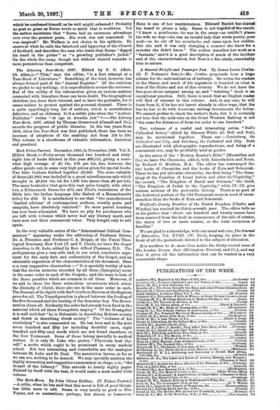Book Prices Current. December, 1895, to November, 1896. Vol. X.
(Elliot Stock.)ŌĆöForty-seven thousand two hundred and sixty- eight lots of books fetched in this year ┬Ż80,111, giving a some- what high average of ┬Ż1 13s. 10d. per lot, due, however, the editor points out, to some very high prices given for special books. Two folio Cartons fetched together ┬Ż2,900. The more valuable of these (X1,880) was included in a great miscellaneous sale which brought in ┬Ż8,554 10s. 6d. for 1,599 lots (more than ┬Ż5 per lot). The same bookseller that gave this vast price bought, with other lots, a Kilmarnock Burns for ┬Ż70, and Eliot's translation of the Bible into the Indian language (the dialect of a Massachusetts tribe) for ┬Ż82. It is satisfactory to see that "the manufactured `limited editions' of contemporary authors, usually poets and essayists, have absolutely vanished." No more patent humbug has ever been attempted. We have no pity for purchasers who are left with volumes which never had any literary merit, and have now cost their commercial value. They bought only to sell again.
In the very valuable series of the "International Critical Com- mentary" appearing under the editorship of Professor Driver, Dr. A. Plummer, and Professor C. A. Briggs, of the Union Theo- logical Seminary, New York (T. and T. Clark), we have The Gospel According to St. Luke, edited by Rev. Alfred Plummer, D.D. The prolegomena give a very able and, to our mind, conclusive argu- ment for the early date and authenticity of the Gospel, and an admirable exposition of the characteristics of the document. Here is a very suggestive observation :ŌĆö" It is specially worthy of note that the eleven miracles recorded by all three [Synoptics] occur in the same order in each of the Gospels ; and the same is true of the three parables which are common to all three Moreover, if we add to these the three miraculous occurrences which attest the Divinity of Christ, these also are in the same order in each. The Descent of the Spirit with theVoice from Heaven at the Baptism precedes all. The Transfiguration is placed between the feeding of the five thousand and the healing of the demoniac boy. The Resur- rection closes all. Evidently the order had already been fixed in the material which all three Evangelists employ." Of the Evangelist it is well said that "he is Hebraistic in describing Hebrew society and Greek in describing Greek society." The "richness of his vocabulary" is also commented on. He has here and in the Acts seven hundred and fifty (or including doubtful cases, eight hundred and fifty-one) words which are not found elsewhere in the New Testament. Some of these belong specially to medical writers. It is only St. Luke who quotes, " Physician heal thy- self," a motto which ought to be prominent in every medical school Not less interesting and remarkable are the analogies between St. Luke and St. Paul. The annotation leaves, as far as we can see, nothing to be desired. We may specially mention the highly interesting and suggestive commentary on chaps. i.-ii., " the Gospel of the Infancy." This extends to nearly eighty pages. Printed by itself with the text, it would make a most useful little volume.






































 Previous page
Previous page